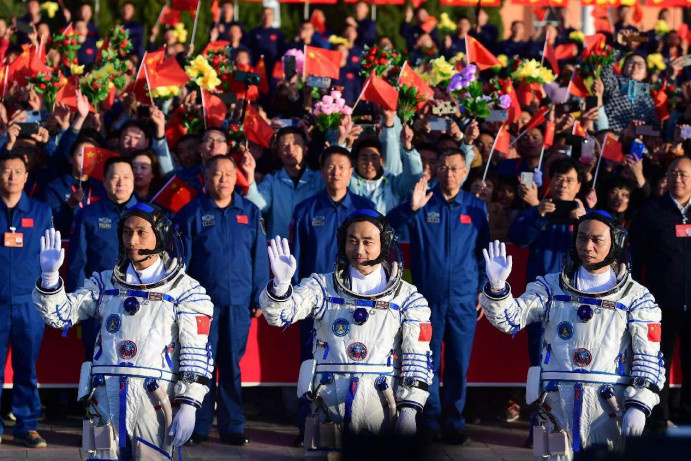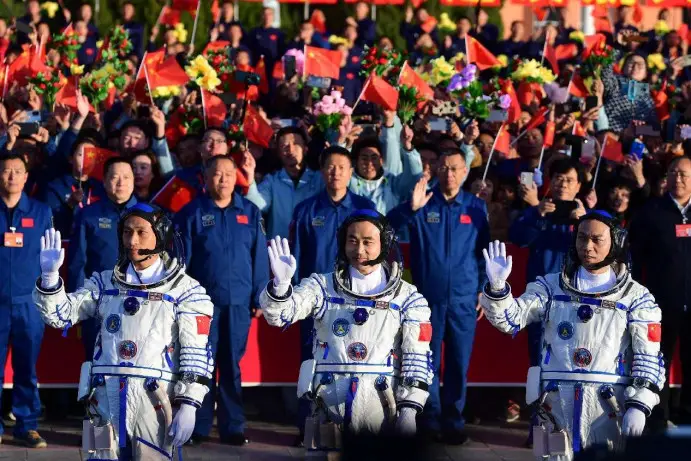By Liu Shiyao, Gu Yekai, People's Daily

Chinese astronauts Tang Hongbo (R), Tang Shengjie (C) and Jiang Xinlin attend a see-off ceremony at the Jiuquan Satellite Launch Center in northwest China on Oct. 26, 2023. (Photo by Wang Xiaobo/People's Daily Online)
At 11:14 a.m. on Oct. 26, a Long March-2F carrier rocket was launched from the Jiuquan Satellite Launch Center in northwest China, sending three astronauts on the Shenzhou-17 manned spaceship into preset orbit. The launch mission was a complete success.
The Shenzhou-17 manned spaceship is the second mission to China's space station since the space station entered its development and application stage. The mission's primary goal includes completing the in-orbit crew rotation with the Shenzhou-16 trio, before they carry on to conduct an approximate six-month stay in space.
During this period, the crew will engage in in-orbit trials of space science and application payloads, conduct astronaut extravehicular activities, and perform payload extravehicular operations, which will also involve the installation of extravehicular payloads and maintenance tasks on the space station.
Besides, the mission will continually evaluate the functional performance of the space station assembly, accumulating precious data and experience regarding space station operations. This initiative aims to assess the coordination and compatibility of the ground support center in managing space station operational tasks, thereby enriching the operational efficiency and troubleshooting capabilities of the space station.
So far, the Shenzhou series of manned spacecraft have all been developed under the leadership of the China Academy of Space Technology (CAST). As the Chinese space station has entered the development and application stage, there will be frequent launch missions of the Shenzhou series, which raises higher requirements for spacecraft development.
“Previous Shenzhou models were produced using a 2D blueprint manufacturing method. Newer models like the Shenzhou-17 have been transitioned to 3D digital manufacturing. Utilizing 3D models to fully convey product definition and process information improves design efficiency and enables 'visualization' of the production process,” said an employee with the CAST.
As the Shenzhou-17 spaceship approached the space station combination, the microwave radar independently developed by the China Aerospace Science and Technology Corporation played a critical role in measurement during the rendezvous and docking process.
The radar can accurately output the distance, velocity, angle and other relative motion parameters between the spacecraft and space station, with low transmit power, high measurement accuracy and strong anti-interference capability.
At the same time, the laser rendezvous and docking radar developed by China Electronics Technology Group Corporation provided precise positioning and measurement support, accurately guiding the rapid rendezvous and docking.
With the full activation of the space station application and development phase, astronauts are playing an even more prominent role in manned spaceflight missions. To better support astronauts working and living in space, the performance of supporting products for the Shenzhou-17 crew has also been further improved.
Through innovative applications of new technologies, in-orbit physical exercise equipment and living supplies for astronauts have been upgraded. They will provide more reliable and convenient guarantees for the astronauts' safe, healthy and efficient work during their six-month stay in orbit.
The Shenzhou-17 and Shenzhou-16 crews will work and live together in orbit for a period of time. The handling capacity of the environmental control and life support system will be increased to meet the demands of six people. So far, the system has been operating stably in orbit for approximately 900 consecutive days.
As a national space laboratory, the orbiting Tiangong space station has carried out applications in an orderly manner, with remarkable outcomes in technology transfer and transformation.
During their stay in orbit, the Shenzhou-17 crew will continue conducting space science experiments and various technology tests.
So far, with close cooperation between astronauts and ground technicians, 70 space experiments have been completed in fields like aerospace medicine, life ecology, biotechnology, materials science, fluid physics, fluid dynamics and others, as well as eight research efforts on human-factors engineering.
A large amount of experimental data has been obtained, and some experimental samples will return with the Shenzhou-16 spacecraft. Some projects have already yielded phased application results.
Lin Xiqiang, deputy director of the China Manned Space Agency, noted that China has a well-equipped near-Earth manned space station and manned transportation system, a mature system for astronaut selection, training and support, as well as manned flight missions scheduled at a frequency of twice per year.
"China is now ready and has made preparations to invite foreign astronauts to participate in flight missions to the Chinese Space Station," Lin added.
The Shenzhou-17 manned spaceship is the second mission to China's space station since the space station entered its development and application stage. The mission's primary goal includes completing the in-orbit crew rotation with the Shenzhou-16 trio, before they carry on to conduct an approximate six-month stay in space.
During this period, the crew will engage in in-orbit trials of space science and application payloads, conduct astronaut extravehicular activities, and perform payload extravehicular operations, which will also involve the installation of extravehicular payloads and maintenance tasks on the space station.
Besides, the mission will continually evaluate the functional performance of the space station assembly, accumulating precious data and experience regarding space station operations. This initiative aims to assess the coordination and compatibility of the ground support center in managing space station operational tasks, thereby enriching the operational efficiency and troubleshooting capabilities of the space station.
So far, the Shenzhou series of manned spacecraft have all been developed under the leadership of the China Academy of Space Technology (CAST). As the Chinese space station has entered the development and application stage, there will be frequent launch missions of the Shenzhou series, which raises higher requirements for spacecraft development.
“Previous Shenzhou models were produced using a 2D blueprint manufacturing method. Newer models like the Shenzhou-17 have been transitioned to 3D digital manufacturing. Utilizing 3D models to fully convey product definition and process information improves design efficiency and enables 'visualization' of the production process,” said an employee with the CAST.
As the Shenzhou-17 spaceship approached the space station combination, the microwave radar independently developed by the China Aerospace Science and Technology Corporation played a critical role in measurement during the rendezvous and docking process.
The radar can accurately output the distance, velocity, angle and other relative motion parameters between the spacecraft and space station, with low transmit power, high measurement accuracy and strong anti-interference capability.
At the same time, the laser rendezvous and docking radar developed by China Electronics Technology Group Corporation provided precise positioning and measurement support, accurately guiding the rapid rendezvous and docking.
With the full activation of the space station application and development phase, astronauts are playing an even more prominent role in manned spaceflight missions. To better support astronauts working and living in space, the performance of supporting products for the Shenzhou-17 crew has also been further improved.
Through innovative applications of new technologies, in-orbit physical exercise equipment and living supplies for astronauts have been upgraded. They will provide more reliable and convenient guarantees for the astronauts' safe, healthy and efficient work during their six-month stay in orbit.
The Shenzhou-17 and Shenzhou-16 crews will work and live together in orbit for a period of time. The handling capacity of the environmental control and life support system will be increased to meet the demands of six people. So far, the system has been operating stably in orbit for approximately 900 consecutive days.
As a national space laboratory, the orbiting Tiangong space station has carried out applications in an orderly manner, with remarkable outcomes in technology transfer and transformation.
During their stay in orbit, the Shenzhou-17 crew will continue conducting space science experiments and various technology tests.
So far, with close cooperation between astronauts and ground technicians, 70 space experiments have been completed in fields like aerospace medicine, life ecology, biotechnology, materials science, fluid physics, fluid dynamics and others, as well as eight research efforts on human-factors engineering.
A large amount of experimental data has been obtained, and some experimental samples will return with the Shenzhou-16 spacecraft. Some projects have already yielded phased application results.
Lin Xiqiang, deputy director of the China Manned Space Agency, noted that China has a well-equipped near-Earth manned space station and manned transportation system, a mature system for astronaut selection, training and support, as well as manned flight missions scheduled at a frequency of twice per year.
"China is now ready and has made preparations to invite foreign astronauts to participate in flight missions to the Chinese Space Station," Lin added.
 Menu
Menu
 Shenzhou-17 manned spaceship successfully launched
Shenzhou-17 manned spaceship successfully launched
















